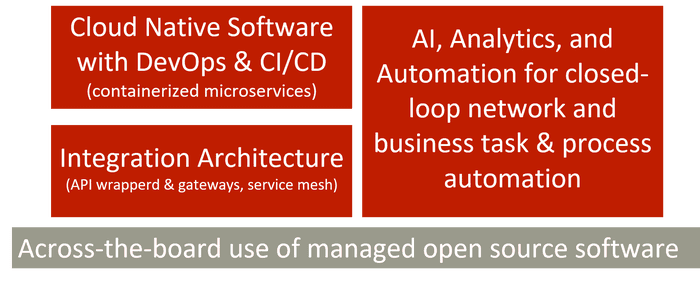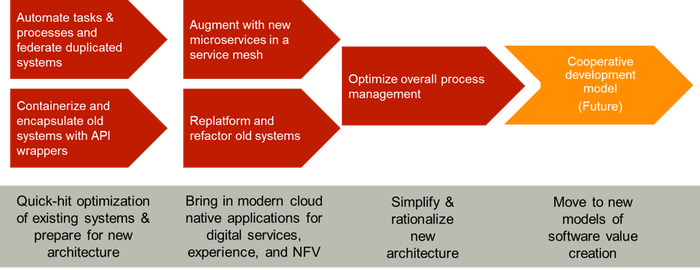Microservices-Based Cloud Native Modernization of OSS/BSS with Open Source
November 25, 2019

By Dr. Mark H Mortensen & Liliane Offredo-Zreik, ACG Research
This article is sponsored by Red Hat
Market forces and changes in subscriber needs and expectations are leading Communications Service Providers (CSPs) to transform their entire service delivery and management infrastructure. At the forefront of this transformation is the modernization of the systems that enable the management of network services, the operations support systems (OSS) and systems for managing the customer and the overall business operations, the business support systems (BSS). Current systems were built for a business paradigm that is increasingly outdated; they are rigid, siloed, rely on extensive human involvement and often require esoteric skills. Modernization of these systems enables CSPs to address requirements for becoming the Digital Service Providers (DSPs) of the future: business agility, elastic scale and capacity, service velocity and the ability to continuously reinvent themselves.
CSPs can build a foundation for successful modernization by standardizing on managed open source because it provides tools and services optimal for continuous integration and automation, critical to future-proof the complex digital business transformation.
THE OSS AND BSS MODERNIZATION IMPERATIVES
The modernization of the OSS and BSS systems has three main requirements:

Figure 1 OSS/BSS modernization imperatives
In this article, we focus on the evolution to cloud-native containerized microservices, powered by managed open source software.
THE OSS AND BSS MODERNIZATION VISION
CSPs need to drive significantly lower costs and a commensurate increase in agility in their business and operations to survive in today’s competitive environment, Their legacy OSS and BSS systems were designed primarily to support the people who operate the workflows (hence, the names Operations and Business Support Systems). These systems need automation and orchestration to evolve toward operating the business, autonomously, under the control and oversight of people.
The new environment will be microservices based. OSS and BSS functions will be instantiated as containerized microservices interconnected via a service mesh, guided by business policies and governance rules, and ultimately overseen by people. This architecture will eliminate silos and provide the underpinnings for continuous integration and continuous development (CI/CD).

Figure 2. OSS/BSS Modernization Vision
EVOLVING TO A MICROSERVICES ARCHITECTURE
The modernization of the OSS and BSS systems should proceed in steps. Undertaking a massive transformation of OSS and BSS systems could result in business disruption and would likely not succeed. Instead, the service provider should start by identifying discrete tasks and well-defined business processes to automate. This enables the organization to reap quick optimization results with minimal disruption, to prove the new technology, and to give employees the opportunity to work in a microservices-based environment. At the same time, the telco can containerize and enhance old systems with API management wrappers. This will require minimal development and disruption, but will improve the reliability, scalability, and IT operations costs.
As new capabilities are added, they should be added as containerized microservices in a cloud native architecture. Once the operator has a substantial set of microservices, it can proceed to redefine the management domains, collapsing the separate domains into a rationalized cross-domain architecture that is optimized for automated operations, not duplicating the organizational structure of the CSP.

Figure 3. OSS/BSS Modernization Journey
As for “monolithic” legacy systems, they will be re-platformed (“lifted and shifted” into containers for more efficient IT operations) and refactored over time into smaller pieces, which may eventually be further refactored into sets of microservices. This may happen all at once, or in stages, balancing the refactoring of the legacy monolith with building new (and refactored) features and functions on the new cloud native architecture.
ENABLING MICROSERVICES ACROSS THE ORGANIZATION
The migration to microservices should be accompanied by important changes across the organization. In the words of Jez Humble, “Reminder: If you’re building microservices, you’re building a distributed system.” Therefore, along with the modernization journey described above, the operator should carefully introduce organizational changes. For example, to maximize the benefits of the distributed microservices environment, the operator should incentivize collaboration, adopt DevOps principles, and introduce the right organizational capabilities for continuous development, continuous testing and continuous delivery. Only when the service provider has taken this comprehensive approach to modernization will it fully realize its goal to become a digital service provider.
CONCLUSION
The modernization journey will be a long process, but one whose benefits match the continuing investment required. A “big bang” investment would likely only deliver benefits in the outer years and may lead to business disruption. However, this transformation process means that the operator will be operating in a hybrid environment, gradually migrating functionality to the cloud. This ongoing transformation with continuous development and integration can best be achieved by using open source technology to ensure that there is no “lock in” to proprietary or obsolete technologies. The open source community is now large enough that technologies that are superseded drive conversion tools available to the next technology. Thus, open source-based transformation future proofs the systems.
If you enjoyed this article and would like to know more then please click here to register for Red Hat’s four part webinar series on BSS/OSS.
Read more about:
Vendor SpotlightsYou May Also Like










_1.jpg?width=300&auto=webp&quality=80&disable=upscale)
